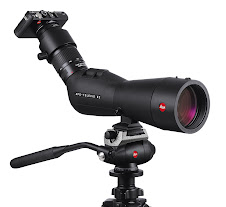No spotting scope has ever been developed with use of a digital point & shoot camera in mind. Conversely, no small p&s camera has ever been designed to couple with a spotting scope; these smaller p&s are generally designed for the masses with close range portraiture and scenic shots in mind (perhaps even a bit of macro for fun). However, through trial & error we've discovered that these two items can indeed be used together to achieve amazing images!
Since neither piece was designed with the other in mind, it has been left to inventive individuals to craft devices to couple cameras & scopes effectively. In the early days of digiscoping experimentation this was done with soda bottles, PVC plumbing fittings, balsa wood, & lots of duct tape. Some designs worked quite well, while others.... well...
Today, digiscoping is a bit more user friendly as major optics manufacturers have recognized digiscoping potential and popularity and most have added at least one branded adapter for use with their products (often more). You can also find a wide array of aftermarket products designed for universal application on many camera and scope models.
Driven by consumer demand, the next generation of tubular adapters were machined to fit specific eyepiece widths. Unlike their universal predecessors, these improved tubular designs (similar to the NEW Leica digital adapter 4 at bottom) fit a specific eyepiece perfectly, slipped on quickly, and the camera was always centered. These adapters have been the choice of many digiscoper in the years since due to their simplicity, compact size, and mounting speed.
Unfortunately, in recent years most digital p&s camera models have discontinued offering accessories, and now there are almost no p&s cameras offer filter threads (maybe 2 or 3 in a field of hundreds). As such, individuals wanting to digiscope with these adapters were forced to seek out a single specific camera model or two. They are now very restrictive as a result. This design can also offer problems as you stack adapters and threaded bushings to connect the camera to the threaded adapter, because the camera lens can be too far from the eyepiece to work to its full potential (see effects of this in post "digiscoping basics 2 - lining up the camera").
In 2006 Leica introduced its unique digital adapter 2. This design took advantage of the mounting speed of the popular tubular design, but featured a revolutionary clamp design allowing use of nearly any digiscoping p&s camera! Two rubber-padded clamp jaws could be adjusted to hold a smaller digital p&s, camera phone and even some smaller video cams in place without dependence on threads. This opened the field to hundreds of camera models.
As with other designs though this increased versatility and compatibility does make the piece a bit larger. The Leica digital adapter 2 (DA2) was machined exclusively to the diameter of the Leica 20-60x zoom, 20x wide-angle, and 32x wide-angle eyepieces, but not other brands. Some of the "tinkerers" in the market were able to adapt this to some other eyepieces with smaller diameters, but again this took a bit of creativity to shim the excess space evenly.

Leica digital adapter3, APO Televid 82 mm spotting scope, & C-Lux camera
Leica introduced the new digital adapter 3 in January of this year. This piece is similar in design to the DA2, but utilizes a unique twist-lock connector at it's base and increased adjustment to accommodate all of the Leica eyepieces from the shorter, thinner former 20x to the largest of the line the new 25-50x wide angle. As such it also will mount to other brand spotting scopes to include many Kowa, Swarovski, Zeiss, & other models with an eyepiece diameter between 53 - 68mm.

Leica digital adapter 4 prototype
However, never fear, for those who prefer simplicity there are options as well. In late summer 2009, Leica will introduce a VERY simplistic option when they introduce the new digital adapter 4. The new DA4 will be machined precisely to the diameter of the 25-50x wide angle eyepiece and will mount directly to only one camera model - the Leica D-Lux 4. By making this piece an exclusive mount for only one camera on a single eyepiece model, you have no need for additional adjustments resulting in a very compact and simplistic adapter.
So if you are wanting to mount a variety of cameras on varying eyepieces or if you simply want to slide the camera on and push the button, the new Leica line-up will offer solutions for all.
















